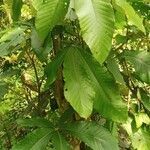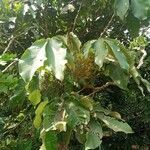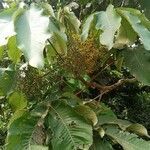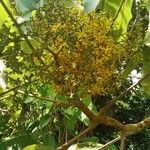A medium sized tree. It grows 15-25 m tall. It branches low down. The crown is dense. The leaves are compound with leaflets arranged like fingers on a hand. There are 5-7 leaflets. Leaves are 90 cm long and 60 cm across. They are leathery and are whitish underneath. There can be teeth along the edge. The male and female flowers are separate. The male flowers are in long stalks and are yellow. The female flowers are in small balls. The fruit are large and yellow. They have 4 or 5 sided sections. Fruit can be 20 cm across. Each sections contains a hard oval seed.
A tree to 65 ft. high, with spreading branches from a short stem
Fruits yellow when ripe
Male flowers yellow





